by Jason Bodner
August 26, 2025
Ever since the Kansas City Federal Reserve began holding its annual Jackson Hole symposium in 1982, markets have often used the central bankers' words there as a turning point in the markets. The remote setting in Wyoming has become a global stage, where a few carefully chosen phrases can move trillions of dollars across stocks, bonds, currencies, and commodities, including gold. Friday was no exception.
As I sat down to write this column, Jerome Powell delivered his final speech from Jackson Hole, and his words cracked open the door to a September rate cut. Markets responded instantly. The S&P 500 surged by 1.5%, the NASDAQ rose 1.9%, and the small-cap Russell 2000 exploded up by 3%. Oil, gold, silver, and even Bitcoin all rallied. Bond yields understandably fell, from 4.30% to 4.25% on the 10-year Treasuries.
Friday's immediate reaction was a sign of just how much investors have been craving clarity. For years, equity markets have been navigating a turbulent August, traditionally one of the bumpiest months of the year. Now, Powell's comments have provided some reassurance and a spark of positive momentum.
The Big Money Index (BMI), a measure of institutional buying, currently sits at 67%: a comfortable zone, well below the overheated 80% level that often signals exhaustion. History shows that being overbought rarely last long: The 35-year average is just 22-trading days. This summer, however, the index remained overbought for 35-consecutive sessions, a streak that ended in early August with predictable turbulence.
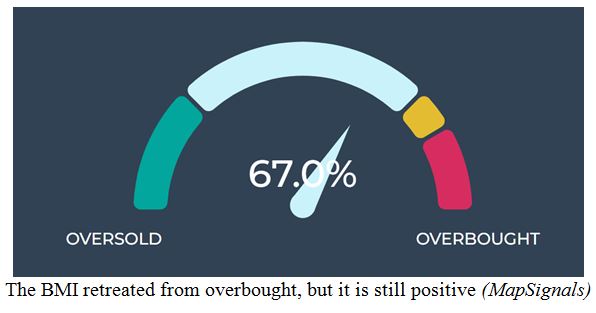
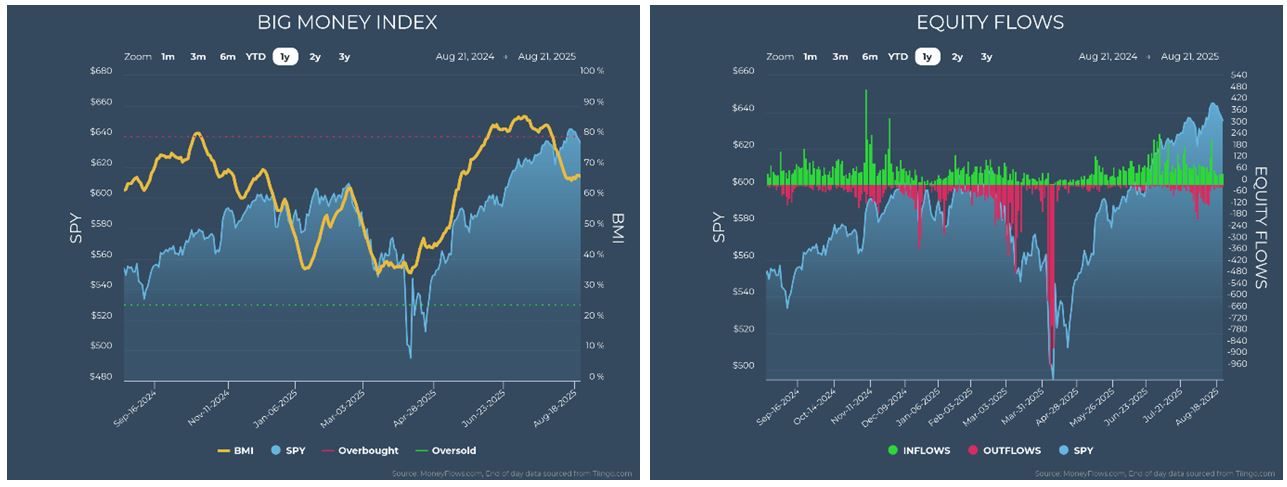
Graphs are for illustrative and discussion purposes only. Please read important disclosures at the end of this commentary.
As expected, the markets hit some "air-pockets" in early August. Outflows spiked briefly, but the selling proved short-lived. By mid-month, inflows returned – particularly into ETFs. The lack of broad ETF outflows is telling, suggesting that investors are still willing to embrace risk, despite temporary volatility.
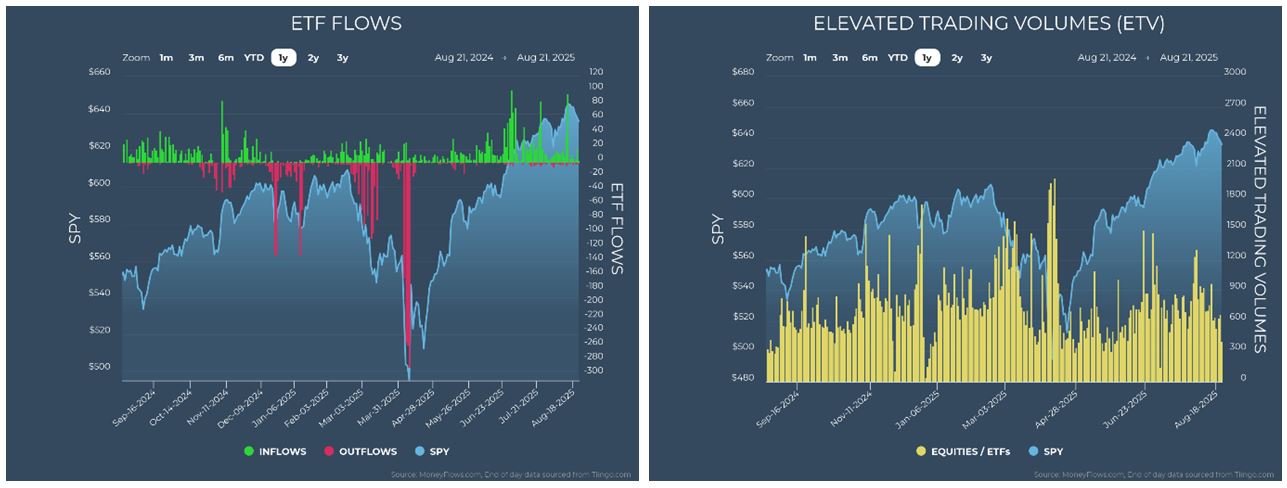
Graphs are for illustrative and discussion purposes only. Please read important disclosures at the end of this commentary.
Another metric worth watching is trading volume. Recent rallies have occurred on lighter participation, raising doubts about their durability, so if Friday's rebound is accompanied by heavier volumes ahead, it will confirm strength. (Stronger volume on up days often precedes a continuation of rallies).
Heading into September next week, this could matter greatly, as September has historically delivered the weakest returns. Since 1990, September has produced negative returns for equities about 60% of the time.
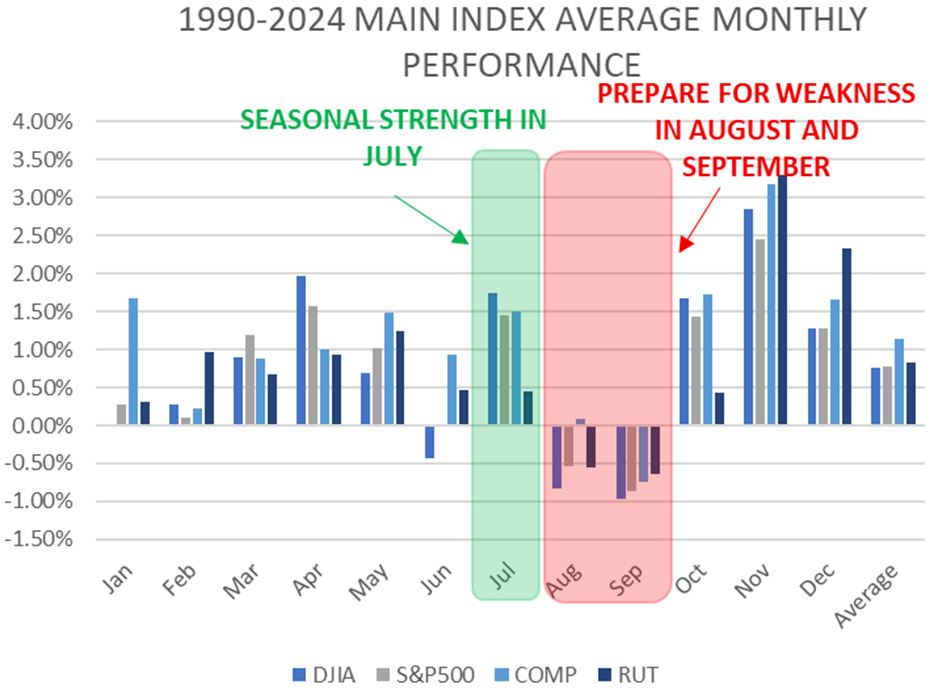
Graphs are for illustrative and discussion purposes only. Please read important disclosures at the end of this commentary.
Earnings season has added fuel to August's volatility. Sharp price swings followed earnings releases, especially in large-cap technology stocks. This is not unusual in summer-months, when lower liquidity amplifies moves, but within the noise, a pattern emerges: Small-cap and mid-cap stocks have been steady beneficiaries.
In fact, 86% of August's inflow signals have been in small and mid-sized companies. That is bullish, suggesting investors are looking beyond the mega-cap darlings and finding value in the broader market.
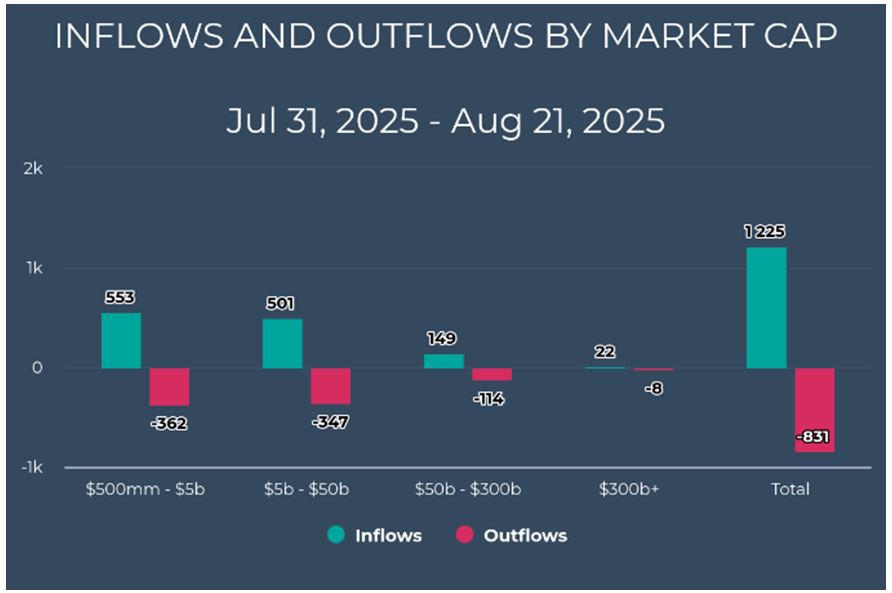
Graphs are for illustrative and discussion purposes only. Please read important disclosures at the end of this commentary.
Sector-level flows tell an equally interesting story. Healthcare has attracted meaningful inflows, while technology has experienced notable outflows. The contrast highlights a rotation beneath the surface, as investors adjust portfolios following blockbuster runs in technology. Some high-flying technology stocks have seen violent retracements, underscoring how quickly sentiment can shift in some of the high-flying names.
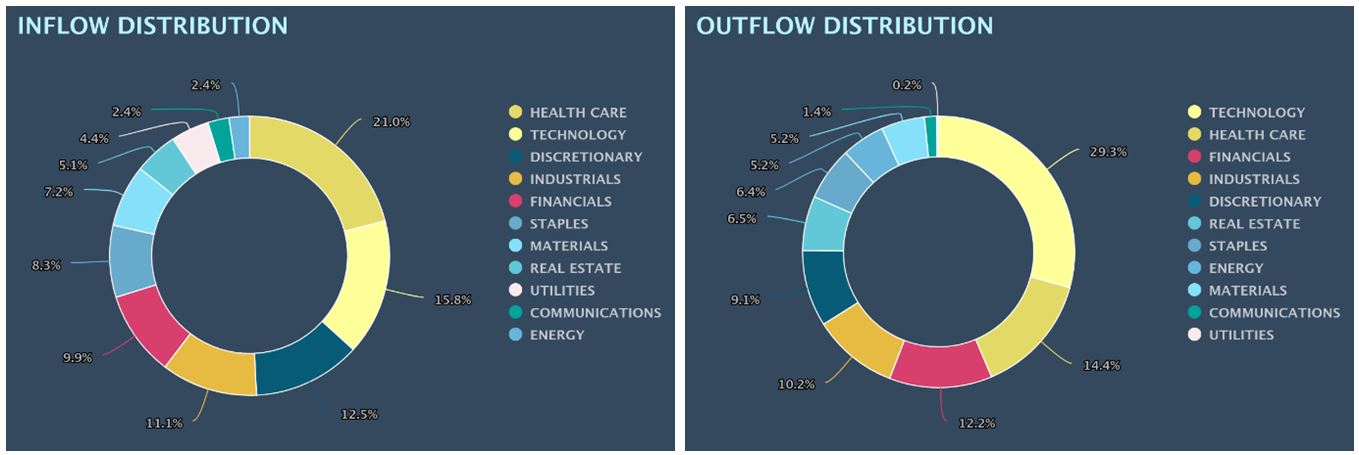
Graphs are for illustrative and discussion purposes only. Please read important disclosures at the end of this commentary.
The Road Ahead
Seasonality suggests caution in the coming weeks. September often delivers turbulence, but with the Fed now signaling policy easing, economic data holding strong and tax-related inflows providing structural support, the backdrop looks constructive. Lower rates should benefit interest-rate-sensitive areas such as real estate investment trusts (REITs), which have lagged but may soon attract yield-hungry buyers.
Beyond REITs, growth-oriented sectors appear well positioned. Technology, consumer discretionary, industrials, and financials all stand to gain from easier monetary policy. Sector rankings currently place utilities at the top, followed by industrials, technology, and financials, with discretionary in the middle of the pack. This composition may shift as investors reposition through the fall.
The stage is set for leadership from growth sectors, supported by a broader rally in equities.
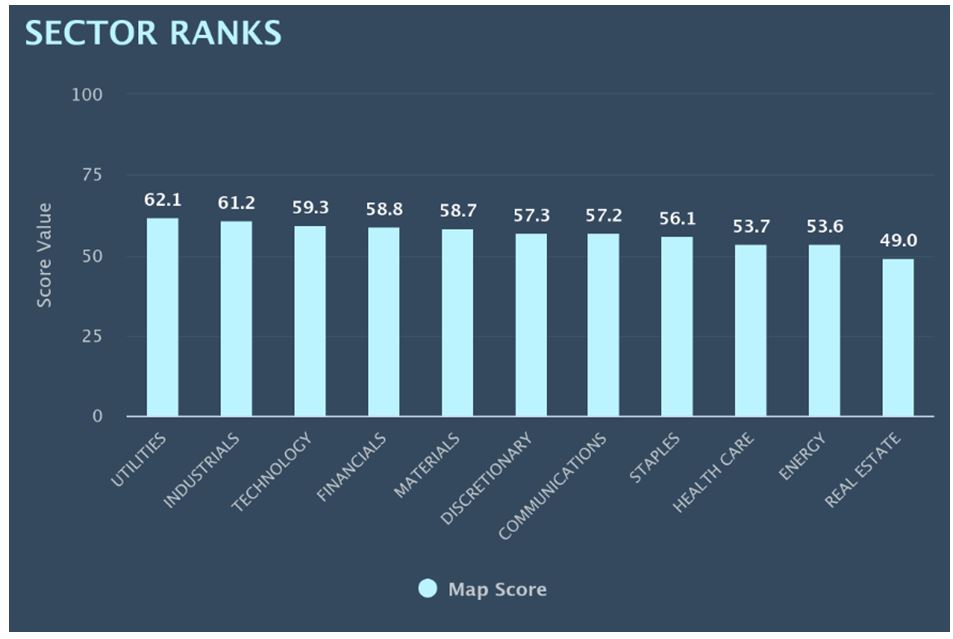
Graphs are for illustrative and discussion purposes only. Please read important disclosures at the end of this commentary.

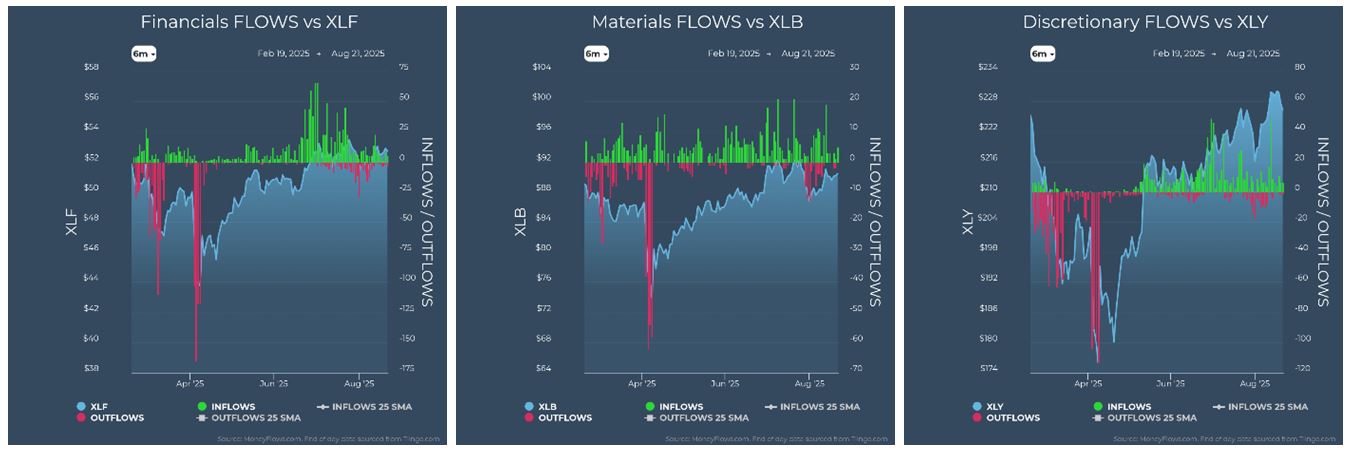
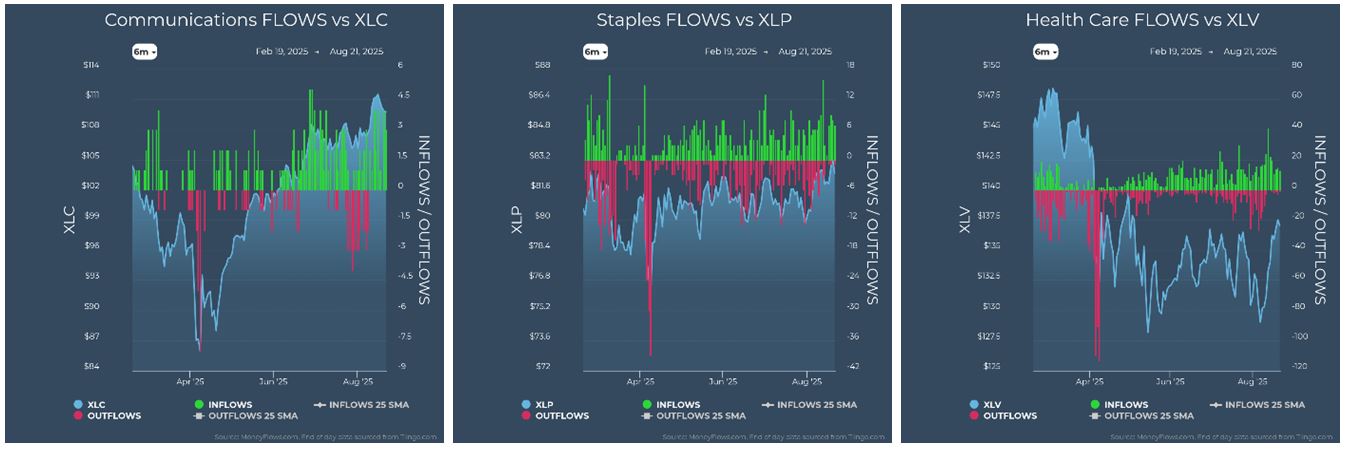
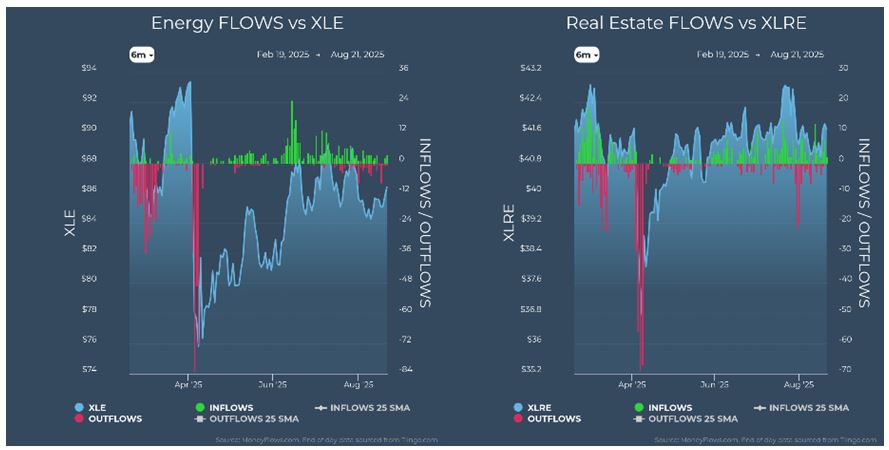
Graphs are for illustrative and discussion purposes only. Please read important disclosures at the end of this commentary.
Earnings Provide the Foundation
Perhaps the strongest argument for optimism lies in corporate earnings. According to FactSet, with 90% of S&P 500 companies reporting Q2 results, 81% posted both earnings and revenue surprises. Earnings are growing at an 11.8% year-over-year pace, marking the third straight quarter of double-digit gains.
Q3 guidance is mixed, with nearly an equal number of companies issuing positive and negative EPS outlooks. Even so, valuations are elevated: The S&P 500 trades at a forward price/earnings ratio of 22.1, above both the 5 and 10-year averages. While that implies some risk, markets have historically tolerated higher multiples in periods of strong growth. For now, earnings momentum provides a sturdy foundation.
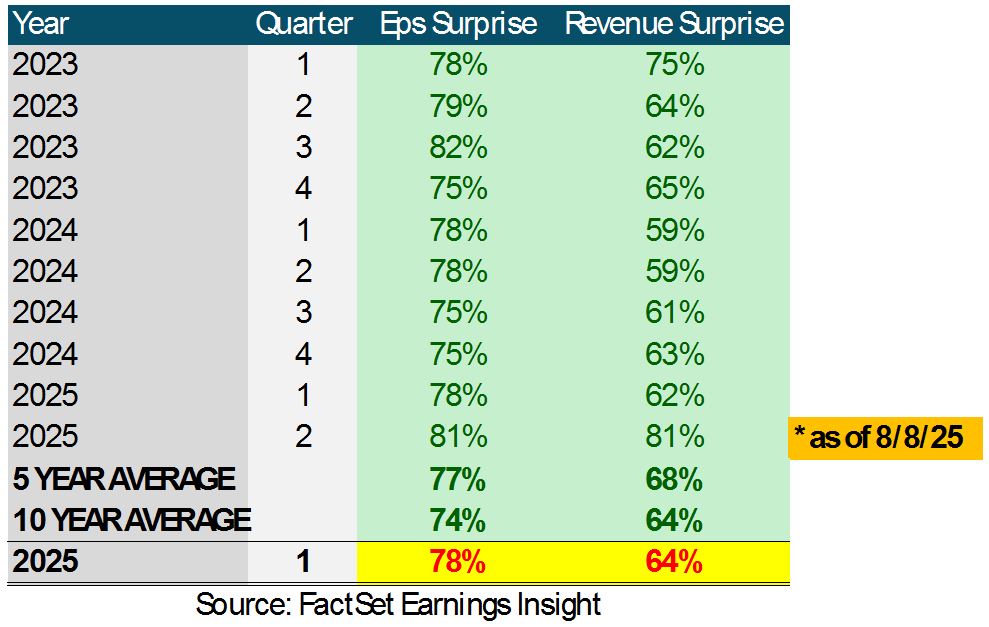
Graphs are for illustrative and discussion purposes only. Please read important disclosures at the end of this commentary.
Powell's Jackson Hole comments could be more than a short-term catalyst. They could be a psychological turning point. For much of the summer, markets have wrestled with uncertainty about monetary policy. Now, with the Fed about to cut rates, investors have a clear framework. Combined with resilient earnings, sector rotation into new leaders and structural inflows, the setup favors continued equity strength.
Of course, risks remain. Valuations are stretched, geopolitical uncertainties linger, and the market must navigate seasonal headwinds. But the pieces are in place for strength going into year-end. The rally that began Friday may mark more than just a relief bounce—it could be the beginning of the next leg higher.
The Stoic Perspective
It is easy to be swept up in the euphoria of green screens and surging prices. But markets, like life, are cyclical. I have been quoting Stoic philosophers on this principle in recent weeks. The Stoic philosopher Marcus Aurelius reminded us: "The universe is change; our life is what our thoughts make it."
This applies to today's environment. Markets shift – through volatility, sector rotations, or seasonal headwinds. What matters is how we interpret those changes. A resilient perspective sees turbulence not as danger, but as opportunity. Just as Powell's Friday words turned uncertainty into momentum, so too can investors transform shifting conditions into growth, provided they maintain discipline and perspective.
In other words, we cannot control markets any more than Aurelius could control the cosmos, but we can control our response, choosing patience over panic, curiosity over fear, and vision over short-term noise.
Maybe that's the Jackson Hole lesson.
All content above represents the opinion of Jason Bodner of Navellier & Associates, Inc.
Also In This Issue
A Look Ahead by Louis Navellier
Ukraine Talks Shift from Alaska to the White House
Income Mail by Bryan Perry
Gold is Set for More Gains, Based on "Weak Dollar" Misconceptions
Growth Mail by Gary Alexander
Labor Day Time Bomb: Fewer Births = Fewer Workers (and Lower Benefits)
Global Mail by Ivan Martchev
The S&P 500 Could Tag 6600 this Week
Sector Spotlight by Jason Bodner
The Market Finds Its Voice at Jackson Hole
View Full Archive
Read Past Issues Here

Jason Bodner
MARKETMAIL EDITOR FOR SECTOR SPOTLIGHT
Jason Bodner writes Sector Spotlight in the weekly Marketmail publication and has authored several white papers for the company. He is also Co-Founder of Macro Analytics for Professionals which produces proprietary equity accumulation and distribution research for its clients. Previously, Mr. Bodner served as Director of European Equity Derivatives for Cantor Fitzgerald Europe in London, then moved to the role of Head of Equity Derivatives North America for the same company in New York. He also served as S.V.P. Equity Derivatives for Jefferies, LLC. He received a B.S. in business administration in 1996, with honors, from Skidmore College as a member of the Periclean Honors Society. All content of "Sector Spotlight" represents the opinion of Jason Bodner
Important Disclosures:
Jason Bodner is a co-founder and co-owner of Mapsignals. Mr. Bodner is an independent contractor who is occasionally hired by Navellier & Associates to write an article and or provide opinions for possible use in articles that appear in Navellier & Associates weekly Market Mail. Mr. Bodner is not employed or affiliated with Louis Navellier, Navellier & Associates, Inc., or any other Navellier owned entity. The opinions and statements made here are those of Mr. Bodner and not necessarily those of any other persons or entities. This is not an endorsement, or solicitation or testimonial or investment advice regarding the BMI Index or any statements or recommendations or analysis in the article or the BMI Index or Mapsignals or its products or strategies.
Although information in these reports has been obtained from and is based upon sources that Navellier believes to be reliable, Navellier does not guarantee its accuracy and it may be incomplete or condensed. All opinions and estimates constitute Navellier's judgment as of the date the report was created and are subject to change without notice. These reports are for informational purposes only and are not a solicitation for the purchase or sale of a security. Any decision to purchase securities mentioned in these reports must take into account existing public information on such securities or any registered prospectus.To the extent permitted by law, neither Navellier & Associates, Inc., nor any of its affiliates, agents, or service providers assumes any liability or responsibility nor owes any duty of care for any consequences of any person acting or refraining to act in reliance on the information contained in this communication or for any decision based on it.
Past performance is no indication of future results. Investment in securities involves significant risk and has the potential for partial or complete loss of funds invested. It should not be assumed that any securities recommendations made by Navellier. in the future will be profitable or equal the performance of securities made in this report. Dividend payments are not guaranteed. The amount of a dividend payment, if any, can vary over time and issuers may reduce dividends paid on securities in the event of a recession or adverse event affecting a specific industry or issuer.
None of the stock information, data, and company information presented herein constitutes a recommendation by Navellier or a solicitation to buy or sell any securities. Any specific securities identified and described do not represent all of the securities purchased, sold, or recommended for advisory clients. The holdings identified do not represent all of the securities purchased, sold, or recommended for advisory clients and the reader should not assume that investments in the securities identified and discussed were or will be profitable.
Information presented is general information that does not take into account your individual circumstances, financial situation, or needs, nor does it present a personalized recommendation to you. Individual stocks presented may not be suitable for every investor. Investment in securities involves significant risk and has the potential for partial or complete loss of funds invested. Investment in fixed income securities has the potential for the investment return and principal value of an investment to fluctuate so that an investor's holdings, when redeemed, may be worth less than their original cost.
One cannot invest directly in an index. Index is unmanaged and index performance does not reflect deduction of fees, expenses, or taxes. Presentation of Index data does not reflect a belief by Navellier that any stock index constitutes an investment alternative to any Navellier equity strategy or is necessarily comparable to such strategies. Among the most important differences between the Indices and Navellier strategies are that the Navellier equity strategies may (1) incur material management fees, (2) concentrate its investments in relatively few stocks, industries, or sectors, (3) have significantly greater trading activity and related costs, and (4) be significantly more or less volatile than the Indices.
ETF Risk: We may invest in exchange traded funds ("ETFs") and some of our investment strategies are generally fully invested in ETFs. Like traditional mutual funds, ETFs charge asset-based fees, but they generally do not charge initial sales charges or redemption fees and investors typically pay only customary brokerage fees to buy and sell ETF shares. The fees and costs charged by ETFs held in client accounts will not be deducted from the compensation the client pays Navellier. ETF prices can fluctuate up or down, and a client account could lose money investing in an ETF if the prices of the securities owned by the ETF go down. ETFs are subject to additional risks:
- ETF shares may trade above or below their net asset value;
- An active trading market for an ETF's shares may not develop or be maintained;
- The value of an ETF may be more volatile than the underlying portfolio of securities the ETF is designed to track;
- The cost of owning shares of the ETF may exceed those a client would incur by directly investing in the underlying securities and;
- Trading of an ETF's shares may be halted if the listing exchange's officials deem it appropriate, the shares are delisted from the exchange, or the activation of market-wide "circuit breakers" (which are tied to large decreases in stock prices) halts stock trading generally.
Grader Disclosures: Investment in equity strategies involves substantial risk and has the potential for partial or complete loss of funds invested. The sample portfolio and any accompanying charts are for informational purposes only and are not to be construed as a solicitation to buy or sell any financial instrument and should not be relied upon as the sole factor in an investment making decision. As a matter of normal and important disclosures to you, as a potential investor, please consider the following: The performance presented is not based on any actual securities trading, portfolio, or accounts, and the reported performance of the A, B, C, D, and F portfolios (collectively the "model portfolios") should be considered mere "paper" or pro forma performance results based on Navellier's research.
Investors evaluating any of Navellier & Associates, Inc.'s, (or its affiliates') Investment Products must not use any information presented here, including the performance figures of the model portfolios, in their evaluation of any Navellier Investment Products. Navellier Investment Products include the firm's mutual funds and managed accounts. The model portfolios, charts, and other information presented do not represent actual funded trades and are not actual funded portfolios. There are material differences between Navellier Investment Products' portfolios and the model portfolios, research, and performance figures presented here. The model portfolios and the research results (1) may contain stocks or ETFs that are illiquid and difficult to trade; (2) may contain stock or ETF holdings materially different from actual funded Navellier Investment Product portfolios; (3) include the reinvestment of all dividends and other earnings, estimated trading costs, commissions, or management fees; and, (4) may not reflect prices obtained in an actual funded Navellier Investment Product portfolio. For these and other reasons, the reported performances of model portfolios do not reflect the performance results of Navellier's actually funded and traded Investment Products. In most cases, Navellier's Investment Products have materially lower performance results than the performances of the model portfolios presented.
This report contains statements that are, or may be considered to be, forward-looking statements. All statements that are not historical facts, including statements about our beliefs or expectations, are "forward-looking statements" within the meaning of The U.S. Private Securities Litigation Reform Act of 1995. These statements may be identified by such forward-looking terminology as "expect," "estimate," "plan," "intend," "believe," "anticipate," "may," "will," "should," "could," "continue," "project," or similar statements or variations of such terms. Our forward-looking statements are based on a series of expectations, assumptions, and projections, are not guarantees of future results or performance, and involve substantial risks and uncertainty as described in Form ADV Part 2A of our filing with the Securities and Exchange Commission (SEC), which is available at www.adviserinfo.sec.gov or by requesting a copy by emailing info@navellier.com. All of our forward-looking statements are as of the date of this report only. We can give no assurance that such expectations or forward-looking statements will prove to be correct. Actual results may differ materially. You are urged to carefully consider all such factors.
FEDERAL TAX ADVICE DISCLAIMER: As required by U.S. Treasury Regulations, you are informed that, to the extent this presentation includes any federal tax advice, the presentation is not written by Navellier to be used, and cannot be used, for the purpose of avoiding federal tax penalties. Navellier does not advise on any income tax requirements or issues. Use of any information presented by Navellier is for general information only and does not represent tax advice either express or implied. You are encouraged to seek professional tax advice for income tax questions and assistance.
IMPORTANT NEWSLETTER DISCLOSURE:The hypothetical performance results for investment newsletters that are authored or edited by Louis Navellier, including Louis Navellier's Growth Investor, Louis Navellier's Breakthrough Stocks, Louis Navellier's Accelerated Profits, and Louis Navellier's Platinum Club, are not based on any actual securities trading, portfolio, or accounts, and the newsletters' reported hypothetical performances should be considered mere "paper" or proforma hypothetical performance results and are not actual performance of real world trades. Navellier & Associates, Inc. does not have any relation to or affiliation with the owner of these newsletters. There are material differences between Navellier Investment Products' portfolios and the InvestorPlace Media, LLC newsletter portfolios authored by Louis Navellier. The InvestorPlace Media, LLC newsletters contain hypothetical performance that do not include transaction costs, advisory fees, or other fees a client might incur if actual investments and trades were being made by an investor. As a result, newsletter performance should not be used to evaluate Navellier Investment services which are separate and different from the newsletters. The owner of the newsletters is InvestorPlace Media, LLC and any questions concerning the newsletters, including any newsletter advertising or hypothetical Newsletter performance claims, (which are calculated solely by Investor Place Media and not Navellier) should be referred to InvestorPlace Media, LLC at (800) 718-8289.
Please note that Navellier & Associates and the Navellier Private Client Group are managed completely independent of the newsletters owned and published by InvestorPlace Media, LLC and written and edited by Louis Navellier, and investment performance of the newsletters should in no way be considered indicative of potential future investment performance for any Navellier & Associates separately managed account portfolio. Potential investors should consult with their financial advisor before investing in any Navellier Investment Product.
Navellier claims compliance with Global Investment Performance Standards (GIPS). To receive a complete list and descriptions of Navellier's composites and/or a presentation that adheres to the GIPS standards, please contact Navellier or click here. It should not be assumed that any securities recommendations made by Navellier & Associates, Inc. in the future will be profitable or equal the performance of securities made in this report.
FactSet Disclosure: Navellier does not independently calculate the statistical information included in the attached report. The calculation and the information are provided by FactSet, a company not related to Navellier. Although information contained in the report has been obtained from FactSet and is based on sources Navellier believes to be reliable, Navellier does not guarantee its accuracy, and it may be incomplete or condensed. The report and the related FactSet sourced information are provided on an "as is" basis. The user assumes the entire risk of any use made of this information. Investors should consider the report as only a single factor in making their investment decision. The report is for informational purposes only and is not intended as an offer or solicitation for the purchase or sale of a security. FactSet sourced information is the exclusive property of FactSet. Without prior written permission of FactSet, this information may not be reproduced, disseminated or used to create any financial products. All indices are unmanaged and performance of the indices include reinvestment of dividends and interest income, unless otherwise noted, are not illustrative of any particular investment and an investment cannot be made in any index. Past performance is no guarantee of future results.
